The Dell XPS 15 9550 Review: Infinity Edge Lineup Expands
by Brett Howse on March 4, 2016 8:00 AM ESTSystem Performance
The XPS 15 is offered with three processor choices. The base model is the 35-Watt Intel Core i3-6100H, which is a dual-core Skylake chip with a 2.7 GHz frequency and 3 MB of cache. While I’m sure that it’s fine for most tasks, the base model is also lacking a discrete GPU and means you are only going to be using the integrated graphics, which in this case is the HD 530. I would expect the bulk of Dell’s sales to be the Core i5 and i7 models, which also come with the NVIDIA GeForce GTX 960M graphics card. The Core i5-6300HQ is a quad-core, 45-Watt part, that runs between 2.3 and 3.2 GHz, and it has a 6 MB cache. The top option is the Core i7-6700HQ, which includes HyperThreading (the Core i5 lacks this but the Core i3 has it) and a base frequency of 2.6 GHz with a turbo frequency of 3.5 GHz. The Core i7 is the model that was provided to us for this review.
On the memory side, this device includes two SODIMM slots which is a nice bonus for upgradability. The base offering is 8 GB of DDR4-2133, and you can buy it with 16 GB as well, or if you want to add your own DIMMs you can put 32 GB in this machine. For storage, hybrid hard drives are at the low end of the device range, but Dell ramps up to PCIe based SSDs on the higher priced models. The review unit has a PM951 Samsung drive, which is the TLC version that we’ve already seen in many notebooks this year. Read speeds are generally great, but write speeds will be among the slower PCIe SSDs thanks to the TLC.
I’ve run the XPS 15 through our standard notebook suite, along with a couple of other tests as well. All laptops in the charts below are from our Notebook Bench, and if you’d like to compare the XPS 15 to any other device we’ve tested, please check it out here. The previous generation XPS 15 9530 in the charts has the Core i7-4702HQ processor, GTX 750M GPU, 3200x1800 display, and a 91 Wh battery. The Lenovo Y700 is a device that we just reviewed and has the same CPU and GPU as the XPS 15 9550, and I thought it would be interesting to also see the XPS 13 here as well, although this is the Broadwell version we reviewed last year. This is a Core i5-5200U CPU, 3200x1800 display, and 8 GB of memory.
PCMark
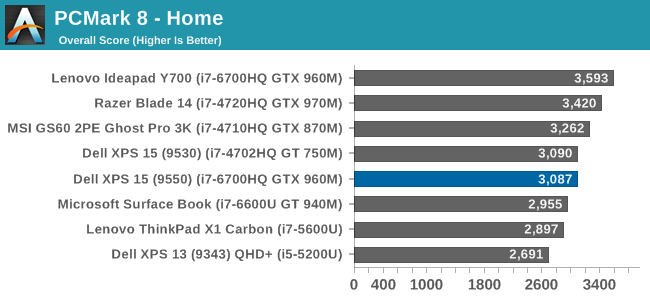
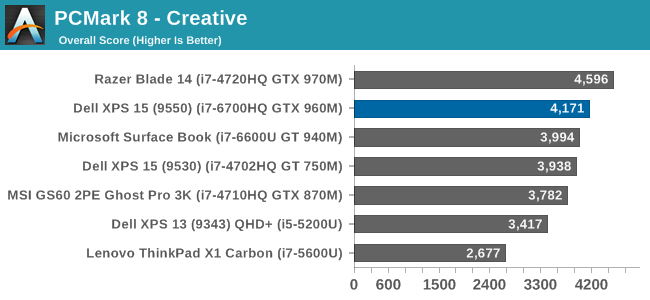
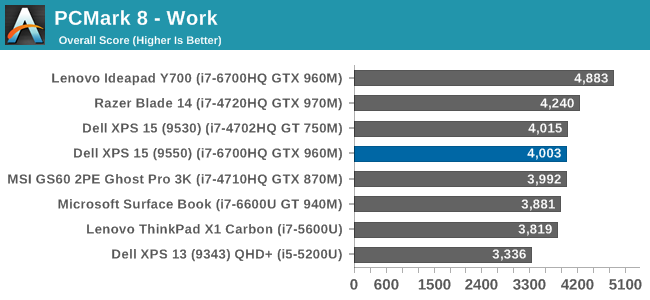
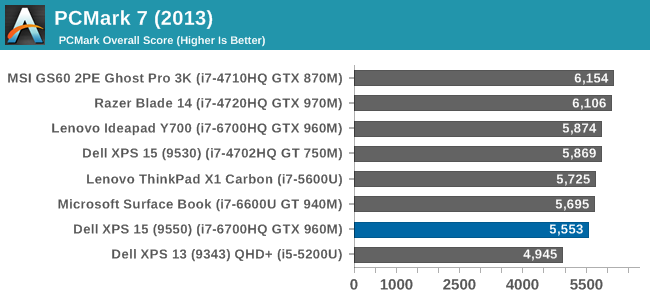
PCMark attempts to recreate actual workloads that people would use every day, and with version 8 they have several tests to focus on workloads for those tasks. Home includes web browsing, gaming, photo editing, and video chat. Creative has web browsing, photo editing, group video chat, transcoding, and some gaming, and Work has document editing, spreadsheets, and video chat. Pretty much all aspects of the device are tested, and even things like the display resolution can impact the score. The UHD resolution on the review unit impacts these scores quite a bit in fact, with the XPS 15 often quite low compared to the Lenovo Y700 which has the same CPU and GPU but a 1920x1080 display.
Cinebench
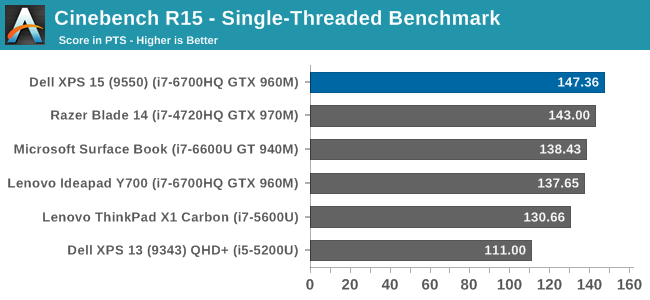
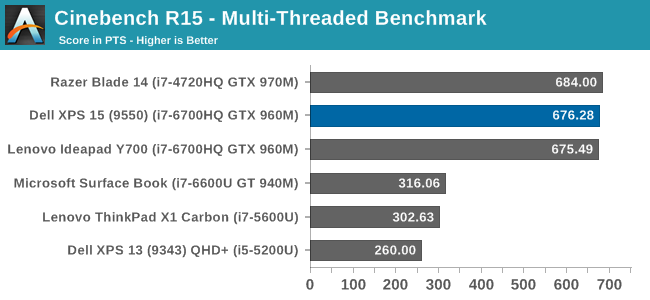
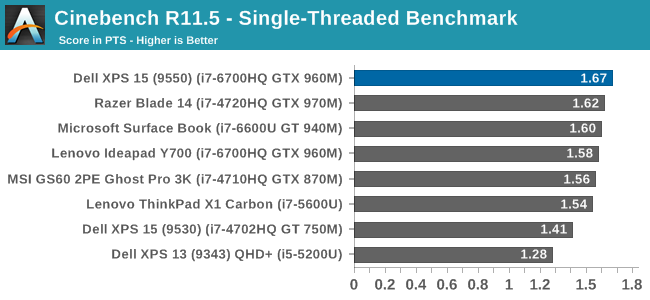
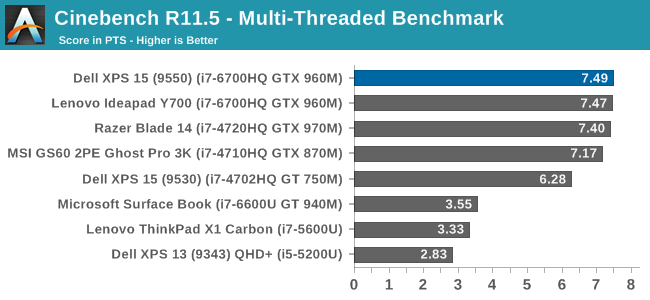
Cinebench is a CPU heavy workload which renders an image. It can use all cores and likes more MHz as well. Just like the Lenovo Y700, I found the XPS 15 wasn’t a big jump in performance with Skylake compared to Broadwell and even some of the later Haswell Core i7 parts. It is however a sizeable jump over the outgoing XPS 15 9530.
x264

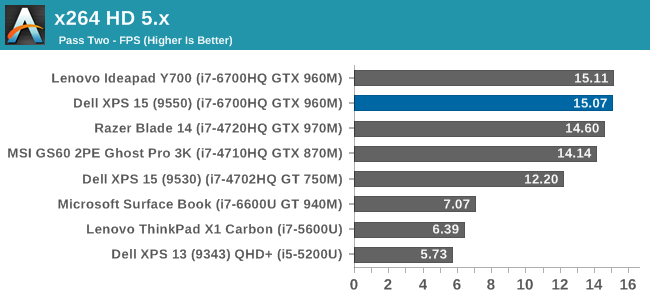
This test does video transcoding, and much like Cinebench is strongly influenced by CPU performance. More cores and higher frequencies are the name of the game here. Just like Cinebench, there also isn’t an increase in performance with Skylake on these tests compared to Broadwell or later generation Haswell chips like the i7-4720HQ, which can turbo up to 3.6 GHz compared to 3.5 GHz on the i7-6700HQ. But it is still a big jump over the i7-4702HQ found in the XPS 15 9530.
Web Tests
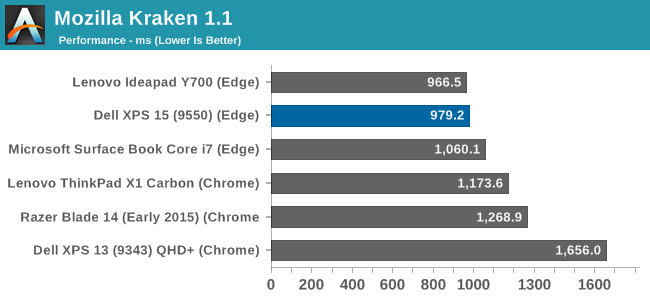
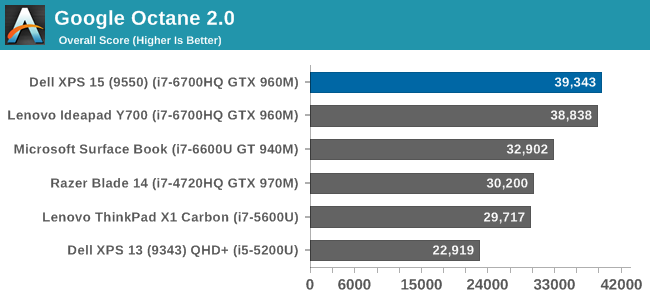
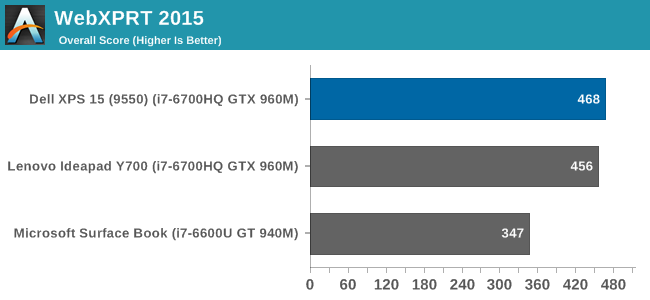
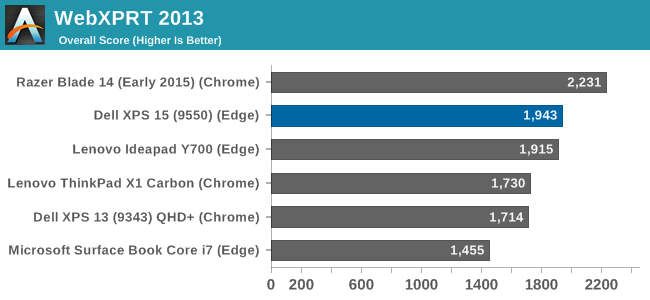
I’ve mentioned this a few times already but its worth repeating. Since the launch of Windows 10, we’ve switched from using Google Chrome for web testing to Microsoft Edge. Edge has performance that is quite a bit closer to Chrome now, surpassing it in some tests and behind in others, but both are capable browsers. As such, I’ve labeled the older laptops to let you know which browser was used at the time they were tested.
With a quad-core Skylake processor, which now supports Intel’s Speed Shift technology, the XPS 15 scores very well in our web results. The bursty nature of the web tests really plays into the hands of Speed Shift and lets the processor quickly get up to maximum frequency to perform the task, and make for a more responsive browsing experience.










152 Comments
View All Comments
Brett Howse - Monday, March 7, 2016 - link
The extra half pound is the larger battery, which takes up the space of the 2.5" hard drive bay. If you get the large battery you can't get the HDD.doubledeej - Saturday, March 5, 2016 - link
Dell lost me as a customer when they started removing the dedicated Home, End, PageUp, and PageDown keys from their keyboard. It makes their laptops next to impossible to use productively for writing code or documents, which is about all I do these days.arswihart - Saturday, March 5, 2016 - link
I have this laptop, it's balls out, better display than Macbook Pro, light as a first-generation 13" ultrabook. Don't care about key travel, touch pad works great, beautiful to behold.nerd1 - Saturday, March 5, 2016 - link
Key travel is clearly worse than older XPS series and thinkpads, but about the same as macbook retina (and way better than new apple wireless keyboard for DESKTOP)People seem to adapt to absolute miserable key travel of new macbook/ipad pro anyway.
Notmyusualid - Sunday, March 6, 2016 - link
Sorry if I missed it.Name the wireless card please...
Much appreciated.
Notmyusualid - Sunday, March 6, 2016 - link
No worries, found it:BCM43602.
Someone out there is reporting that the connector sizes do not match existing wifi cards.
Pulled a 7260 from my AW18, and was hoping to finally find an upgrade to my trusty 6300N, which blows the newer .ac card out the window (for range).
Oh well.
Xajel - Sunday, March 6, 2016 - link
Hmmmm, I was off-listing Dell from my list of laptop options mainly duo to their chargers ( that weak data pin+wire which tends to fail and stops the laptop from charging while the charger is still working )... but this laptop is good I see, I might live with that charger thing but I have two things...I believe the laptop can be configured with the 1080p panel, so it will be better in terms of battery life. but AFAIK the 4K panel is superior in terms of picture quality which I prefer over half hour battery life specially that the 4K panel will have some DPI issues also...
But I would love to see a repetition of the display tests but for the 1080p panel to see the difference... the other thing I would like to know is the Type-C port, I believe the article mentioned it capable of power delivery also... does this mean that we can charge the laptop also ? if true then is the original charger 90W or 120W ? I'm asking this coz the Type-C spec. can handle up to 100W so if the laptop require a 90W charger then it won't be a problem, but if it requires 120W charger then charging will be a little slower ( unless the laptop was idle or turned off )
In all cases -even with slower charging- I prefer a standard Type-C charging solution over proprietary one, specially the famous faulty Dell chargers...
Brett Howse - Monday, March 7, 2016 - link
Yes you can charge over the Type-C. The power adapter size is listed in the specs but it's a 130w version, so over Type-C it would charge a bit slower.Ryan Smith - Monday, March 7, 2016 - link
Aye. If it can even accept 20V over Type-C, that still maxes out at 5A @ 20V, for 100W.Soac - Sunday, March 6, 2016 - link
The CrystalDiskMark READ scores are not correct. The Laptop comes setup in RAID mode for some strange reason... When switched to AHCI mode, the Reads go up to 1.7Gbps. I have the 512GB PM951. I would advise checking this out.